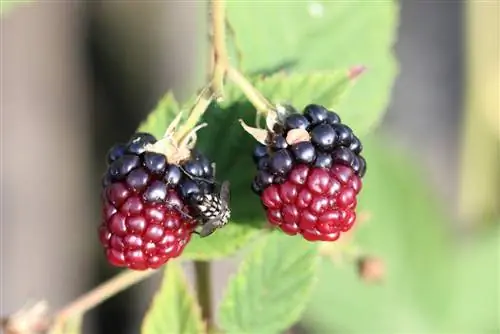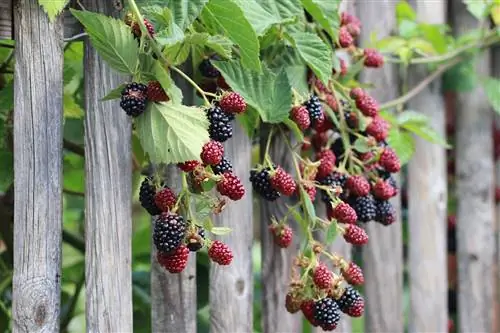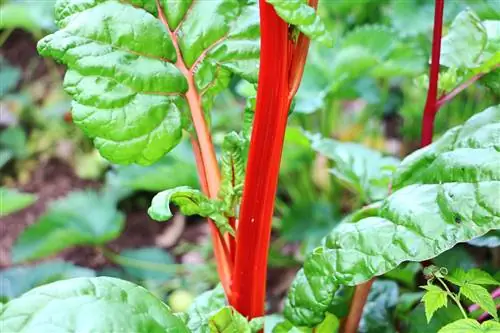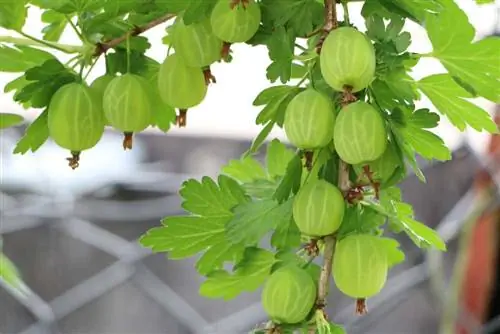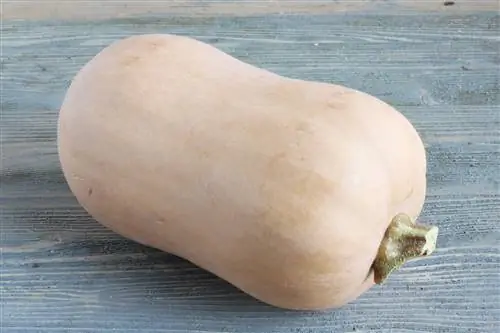- Author admin [email protected].
- Public 2023-12-17 03:39.
- Last modified 2025-01-24 12:45.
The first blackberry plants were brought to Germany from the USA in 1895. Since then they have become one of the most popular garden plants. No wonder: the fruits are extremely sweet and juicy. In addition, it is not particularly difficult to successfully cultivate blackberry bushes in the garden. However, the right planting is crucial if you want to harvest plenty of fruit.
Location
Like most other fruits, blackberries need a lot of light to develop juice and sweetness. A location that is as sunny as possible is therefore ideal for blackberry bushes. However, they also thrive quite well in partial shade. When choosing a location, it is also important that there is enough space. The bushes can become quite sprawling. As a rule, they also need a climbing aid, which can increase the space required. Of course, it doesn't hurt if the plants are at least somewhat protected from the wind. Locations in the immediate vicinity of garden paths are completely unsuitable.
The reason: Blackberries belong to the rose family and therefore form spines. Since the branches of the plant grow wildly and sprawling, there is a high risk of getting your clothing caught in the spines as you walk past.
Tip:
If the plant has to be planted near a path for whatever reason, a minimum distance of around one meter is strongly recommended. You can avoid the problem if you decide to breed without spines.
Floor
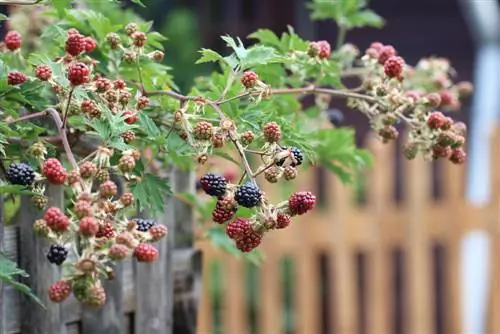
Blackberry bushes are generally relatively undemanding and uncomplicated. This is demonstrated not least by the fact that they can cope well with practically any type of soil. However, the plant feels really comfortable in slightly acidic soil. A pH that is somewhere between 5 and 6.5 is ideal. If the value is above 7, some lime can be added to the soil to make the blackberry bushes happy. However, a more acidic soil is not absolutely necessary. What's more important is that it was loosened up well.
Varieties
Before you can start planting, you first have to decide on a specific type of blackberry. There are now countless breeds. The main difference is usually that the varieties either have spines or not. The yields and fruitiness can also vary greatly. Here is a brief overview of the most common varieties.
Theodor Reimers
- the classic par excellence
- prickly
- very productive and very fruity
- Fruits ripen between the end of July and mid-September
Loch Ness
- prickly
- average yield
- sour-aromatic taste
- Ripe time end of July to mid-September
Lubera Navaho
- is considered the ultimate among new breeds
- no spines
- high yield
- very aromatic
- low stature
- does not require climbing aid
- Ripening period end of July to mid-October
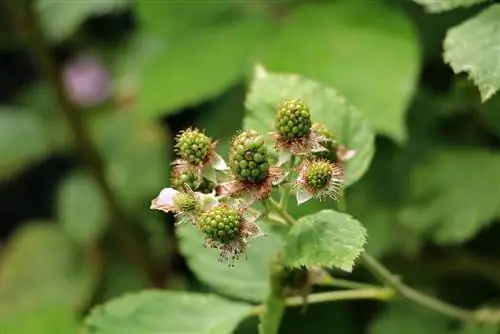
All of these varieties are recommended. The best place to buy blackberry plants is from a gardening store. Before buying, however, you should take a close look at each individual plant. It is important that it has at least three he althy, fresh green shoots. In addition, it should not have any injuries or dried areas of bark.
Tip:
Before purchasing, take the plant out of its plant pot. If no soil is released, the root ball is optimally rooted and ready to be planted immediately.
Planting
If you want to enjoy your blackberry plants and their fruits for a long time, you should definitely pay attention to a few points when planting. In fact, blackberry success depends largely on planting correctly. The preparation of the soil and the planting distance play a major role.
Planting time
Blackberry bushes with thorns can basically be planted all year round. However, early spring is ideal for this. If you plant your blackberries in April you really can't go wrong. With thornless varieties, however, things are a little different. They are usually much more sensitive to frost than their spiny relatives. They must therefore be planted in spring or summer when there is no longer any risk of ground frost.
Preparation
Before the planting troughs can be dug, the soil must first be loosened as deeply as possible. The best way to do this is to use a rake. The loosening should be done at least to a depth of around 40 centimeters. This makes it much easier for the roots of the blackberry bush to take root. If the soil is low in humus and therefore also nutrient-poor, now is the right time to mix the loosened soil with potting soil or rotting leaves. This ensures a good supply of nutrients for the young plants right from the start. Parallel to these activities, the root balls of the blackberry plants are watered for a few minutes. To do this, place the respective root ball in a bucket full of water - so that the entire ball is below the water surface.
Planting spacing

As a rule, you will not limit yourself to one blackberry bush, but rather plant several bushes at the same time. The distance is particularly important. Since most varieties grow very sprawling, it is extremely advisable to choose the distance so that the bushes do not get in each other's way. Depending on the variety and growth rate, the necessary distance can vary considerably. As a rule of thumb, a distance of 1.5 meters is usually sufficient. The bushes can be planted in a row or grouped differently.
Tip:
You can have even more blackberry fun if you combine different varieties when planting. This ensures variety and different taste experiences.
Planting
Before planting, planting troughs must be dug. The size is based on the size of the respective root ball. It has to fit easily into the hollow. Ideally there is a distance of five to ten centimeters from the side walls of the trough. The top of the bale should definitely be below the ground surface.
Tip:
When digging out the trough, place the root ball in question into the small hole every now and then in order to be able to estimate the size ratio.
Drainage can be installed at the bottom of the hollow to improve the flow of irrigation water. Small stones or horn shavings are suitable for this, as they also provide a certain fertilizing effect. The root ball is then carefully placed in the middle of the drainage. The sides are filled with the soil from the hollow. The top of the bale is also covered with soil. The filled soil must then be trampled or tapped into place. Now just water intensively and the blackberry bush is officially planted.
Tip:
If you cover the area around the trunk with bark mulch immediately after planting, the soil will dry out less quickly. The plant needs a lot of water, especially to root.
Trellis
With the exception of the Lubera Navaho variety, blackberries quickly develop a large tangle of shoots. They are happily growing around. That wouldn't be a problem in itself if this chaos didn't make it significantly more difficult to harvest the fruit later. To prevent this, you should definitely work with a trellis right from the start. The shoots are then guided alternately through the individual cross wires of the trellis. In this way, the plant is educated, so to speak. You can quickly build a trellis like this yourself. Simply ram two approximately 1.70 meter long wooden stakes into the ground to the left and right of the plant or row of plants and then stretch four to five plastic-coated wires between them. The distance between the first wire and the ground should be around 50 centimeters, the remaining distances between the wires around 30 centimeters.
Maturity
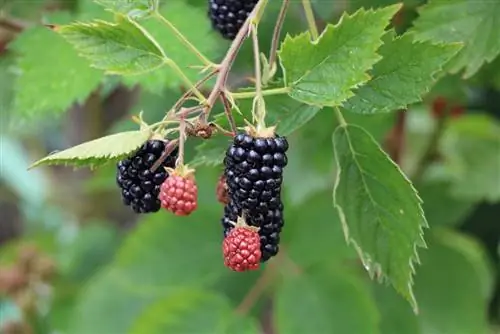
When exactly the fruits on the blackberry bush are ripe depends on the variety, the location and the weather conditions. Harvesting can normally take place in the summer months from July to mid-September. You can tell when they are ripe because the blackberries have usually turned a deep black color. They are also very soft and can be removed from their shoots extremely easily. If in doubt, just try it. If they taste sweet and are very juicy, it is actually high time to harvest them. You should be very careful when doing this so as not to crush the soft fruits. They are best collected in a basket in which they can lie relatively loosely.

